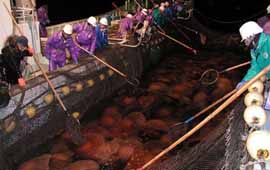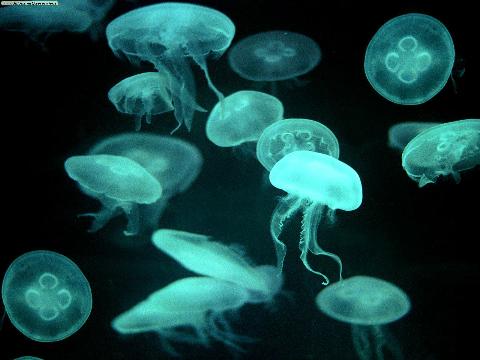Team:Valencia/The Town Dock
From 2009.igem.org
| Line 4: | Line 4: | ||
#content{ | #content{ | ||
| - | height: | + | height:2400px; |
} | } | ||
</style> | </style> | ||
Revision as of 01:12, 22 October 2009
The Town Dock
In 1962, using the methods that had worked in the previous year, we obtained an additional amount of aequorin and began to study various aspects of the molecule, including its application in the measurement of calcium ions. We also wanted to know the mechanism of the luminescence reaction and the structure of the light-emitting chromophore. But our efforts to achieve these goals were soon blocked by an insuperable difficulty. When various methods were used to break down the molecules of aequorin, the first step of the reaction was always an intramolecular chemical change; so it was impossible to isolate intact chromophores. We therefore decided to postpone further study on the light-emitting mechanism.
In 1967, Ridgway and Ashley reported their observation,
with the aid of microinjected aequorin, of transient
Ca2+ signals in single muscle fibers of the barnacle. It was
the first report on the use of aequorin in studying intracellular
calcium, and it was soon followed by hundreds
of papers. Because the importance of aequorin was now
evident, we wanted to study the chemistry of the luminescence
reaction. Although the structure of the native
light-emitting chromophore seemed intractable, I thought
that the structure of the chromophore after the luminescence
reaction could be determined. For a structural study
of the chromophore, I estimated that 100-200 mg of pure
aequorin would be needed in a single experiment. About
50,000 jellyfish (2.5 tons) would be needed to produce
this amount of aequorin. But to process 50,000 jellyfish
in one summer, we would have to collect and cut at least
3000 of the animals each day, allowing for days of bad
weather and poor fishing. This was a workload that could
not be accomplished by collecting jellyfish at the lab dock
and cutting ring with scissors at a rate of one ring per
minute.
We resumed the jellyfish operation at Friday Harbor
in the summer of 1967, not anticipating that it would
continue for the next 20 years. To collect more jellyfish,
we expanded our fishing ground beyond the lab dock,
adding the Chevron dock (a small commercial pier), the
town dock (public pier), and the shipyard (a covered boat
storage), and we used a car to move around and to transport
the buckets ofjellyfish. When the current carried the
stream ofjellyfish far beyond the docks, we also used rowboats
to collect jellyfish, a tricky activity that occasionally
caused a collector to fall into very cold seawater. The
Chevron dock was our favorite place during the first 2-3
years, because there was a part of it where a large number
ofjellyfish would stack up on an early morning tide. We
had to be careful, however, not to make noise that might
awaken sleeping people on the boats.
The town dock was very small-almost nonexistentin
the late ’60s; but then it was rapidly expanded. By 1975,
the dock had been extended far enough into the bay to
intersect with the main jellyfish stream, and it then became
a highly favorable spot for fishing. Indeed, the town dock
with its large sign saying “Port of Friday Harbor” became
our main fishing ground, and the collection became much
easier than before. We harvested jellyfish every morning
and evening. The collectors were usually my wife, our son
and daughter, a couple of assistants, and me. Dr. and
Mrs. Johnson also helped for the first several years. Because
the jellyfish are nearly transparent in seawater, they
cannot easily be seen with untrained eyes. Our children
were only 3-4 years old when they began collecting jellyfish
with specially made short nets; they had become as
efficient as an average adult by the age of 8; and through
high school they continued to be great helpers in my project.
Before beginning a collection, we filled buckets about
half-full with seawater and placed them strategically along
the edge of pier, then gathered jellyfish until the buckets
were completely full. When a dense stream of animals
was passing the dock, we could collect at a rate of 5-10
jellyfish per minute. When all the buckets were filled, we
poured off some water to about 80% capacity, and then
covered each bucket with a plastic bag to prevent seawater
from spilling during transportation. The buckets-each
crammed with about 100 jellyfish in very little waterwere
then packed into the trunk of a car (which could
accommodate 12 buckets) and rushed to the lab. More
buckets were usually transported to the lab on a Boston
Whaler by one of the assistants. Once at the lab, and before
any rings were cut, the jellyfish were kept in aquaria to
revive. In this manner, we were able to collect an average
of 3000-4000 jellyfish each day at the town dock.
The town dock was very good for jellyfish fishing, but there were some problems. Often we found too many boats at the dockside; this decreased the open space where we could collect jellyfish. When the loading area, located halfway along the main dock, was fully occupied, we had to carry the heavy buckets of jellyfish all the way to our car, which would be parked more than 200 yards away. The biggest problem, however, was that there were too many boat people who asked us questions. “What are you doing?” “ What are you collecting?’ “How do you use them?’ Almost every passerby felt obliged to ask us a question while we were busily collecting. Most people were satisfied by our simple reply: “These are for scientific research.” Some people persisted until they had received a complete explanation of our research.
I cannot forget a funny exchange that took place one
early morning. An old lady poked her head out from the
window of a small boat, looked at the jellyfish on my net,
and asked me, “How do you cook them?”
I answered, “We don’t cook those jellyfish.”
She gazed at me distastefully, “Do you eat them raw?” and her head disappeared.
“No! We don’t eat them!” But my reply was too late.
 "
"

